A novel mechanism for the anticancer activity of aspirin and salicylates
- Authors:
- Asma'u I.J. Bashir
- Chandra S. Kankipati
- Sarah Jones
- Robert M. Newman
- Stephen T. Safrany
- Christopher J. Perry
- Iain D. Nicholl
-
Affiliations: Department of Biomedical Science and Physiology, School of Sciences, Faculty of Science and Engineering, University of Wolverhampton, Wolverhampton WV1 1LY, UK, School of Pharmacy, Faculty of Science and Engineering, University of Wolverhampton, Wolverhampton WV1 1LY, UK, School of Mathematics and Computer Science, Faculty of Science and Engineering, University of Wolverhampton, Wolverhampton WV1 1LY, UK, School of Medicine, RCSI‑Bahrain, Adliya, Kingdom of Bahrain - Published online on: January 29, 2019 https://doi.org/10.3892/ijo.2019.4701
- Pages: 1256-1270
-
Copyright: © Bashir et al. This is an open access article distributed under the terms of Creative Commons Attribution License.
This article is mentioned in:
Abstract
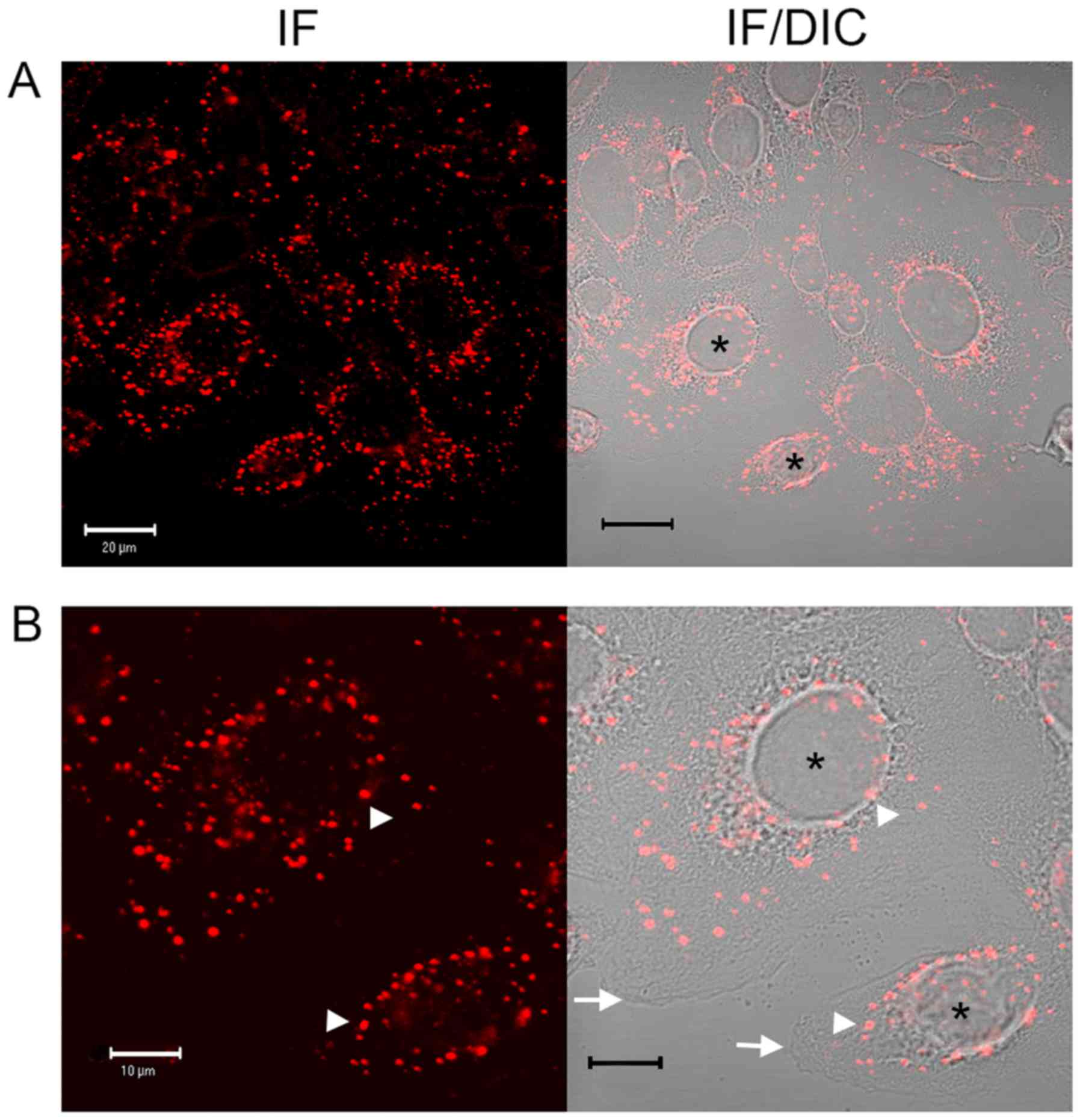 |
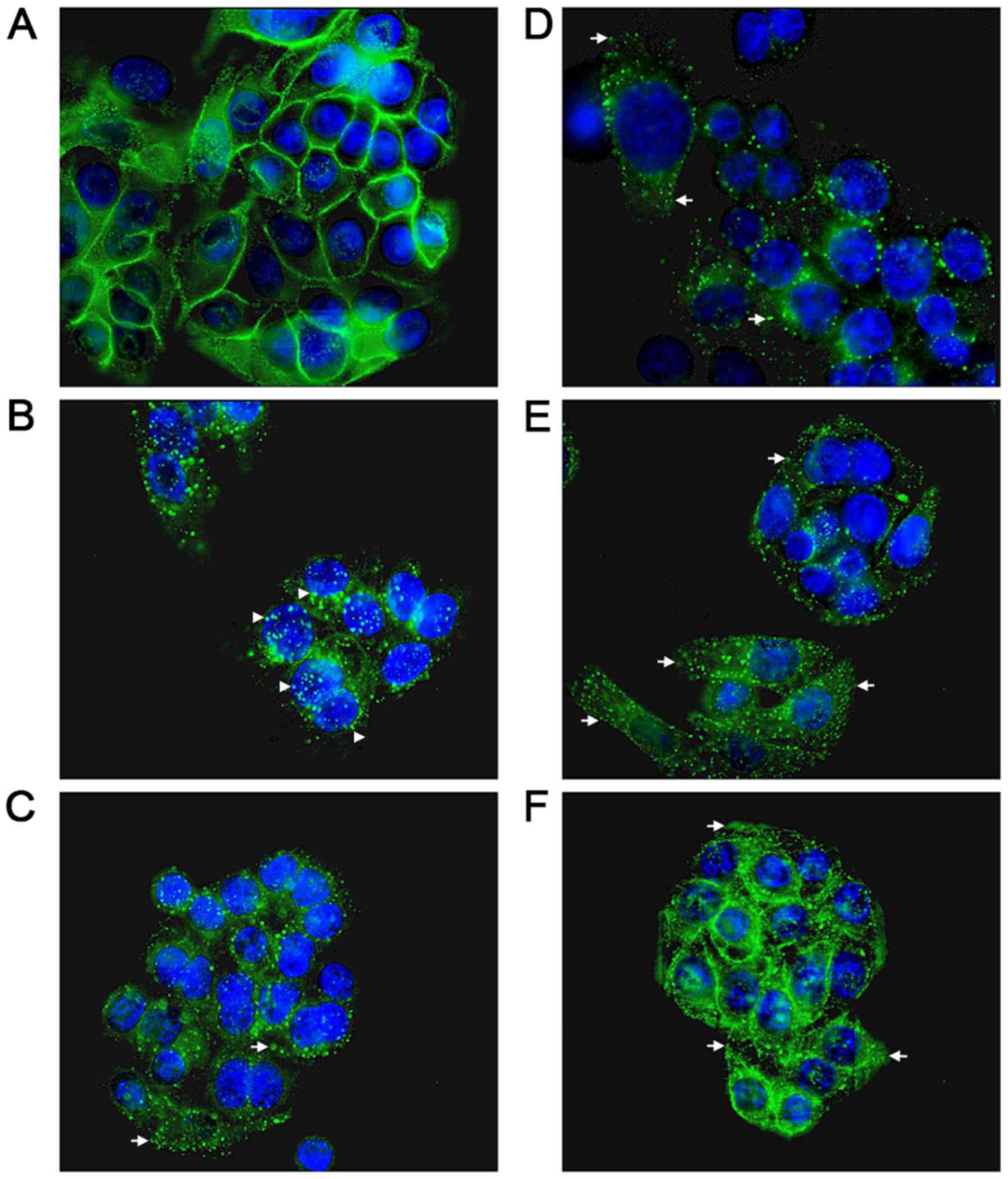 |
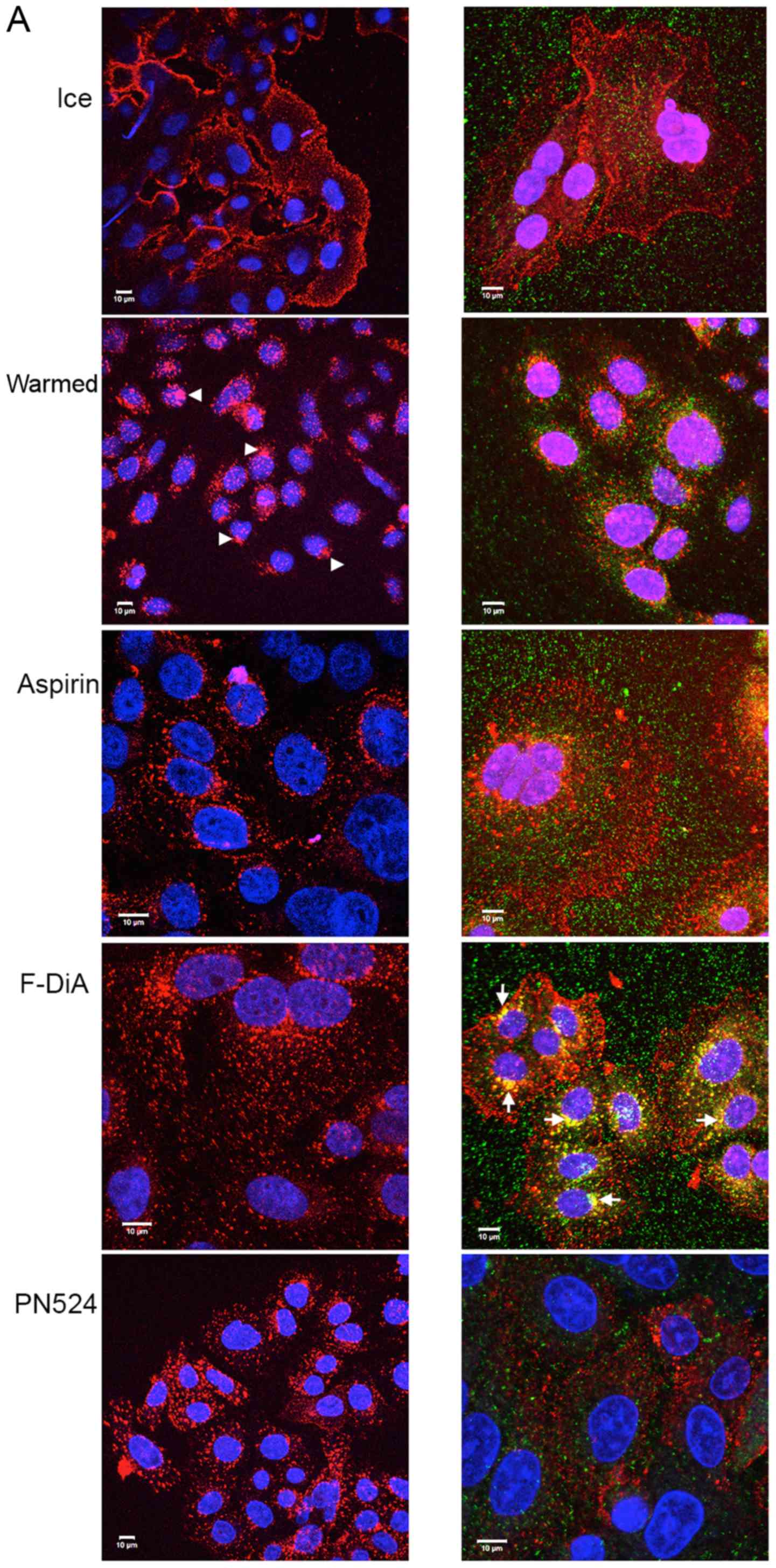 |
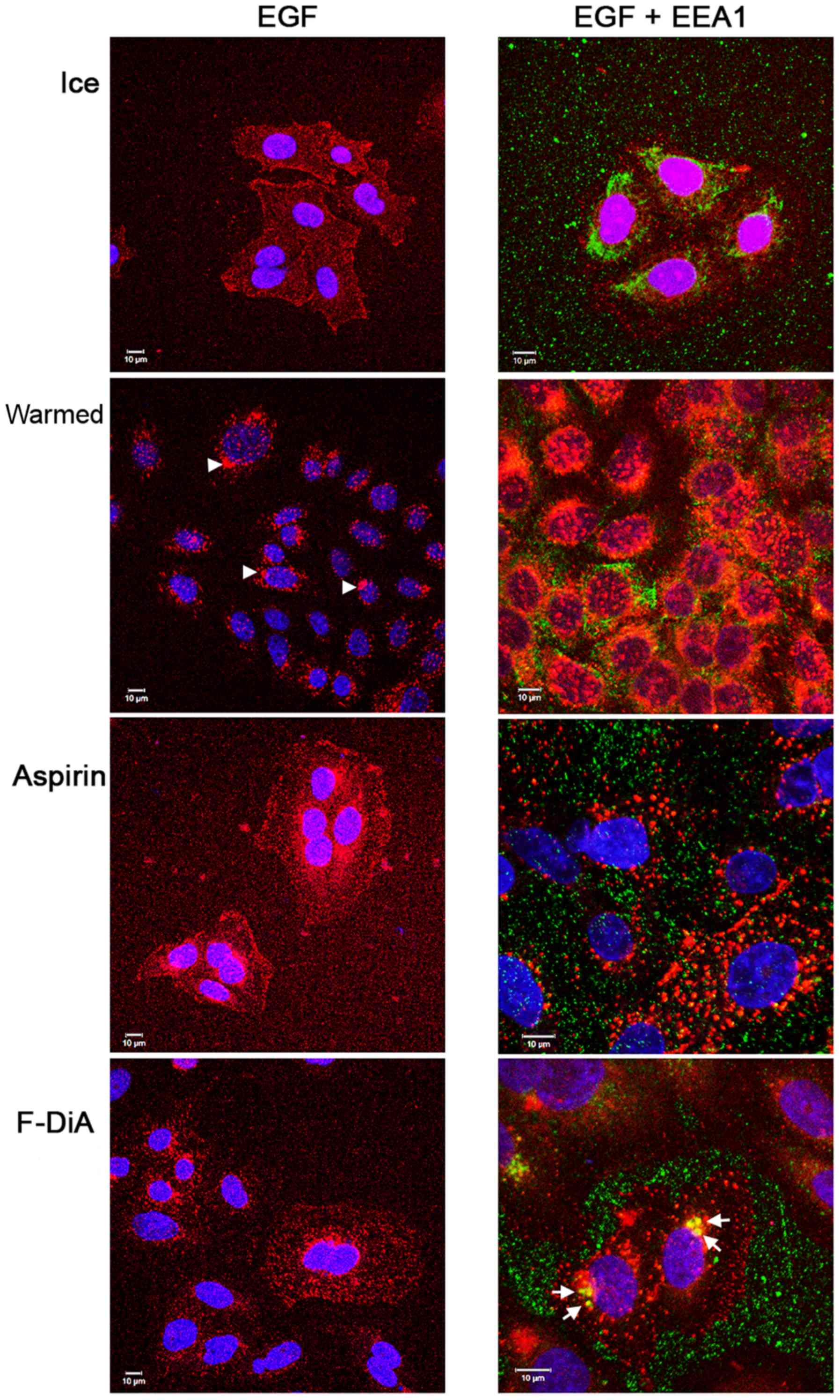 |
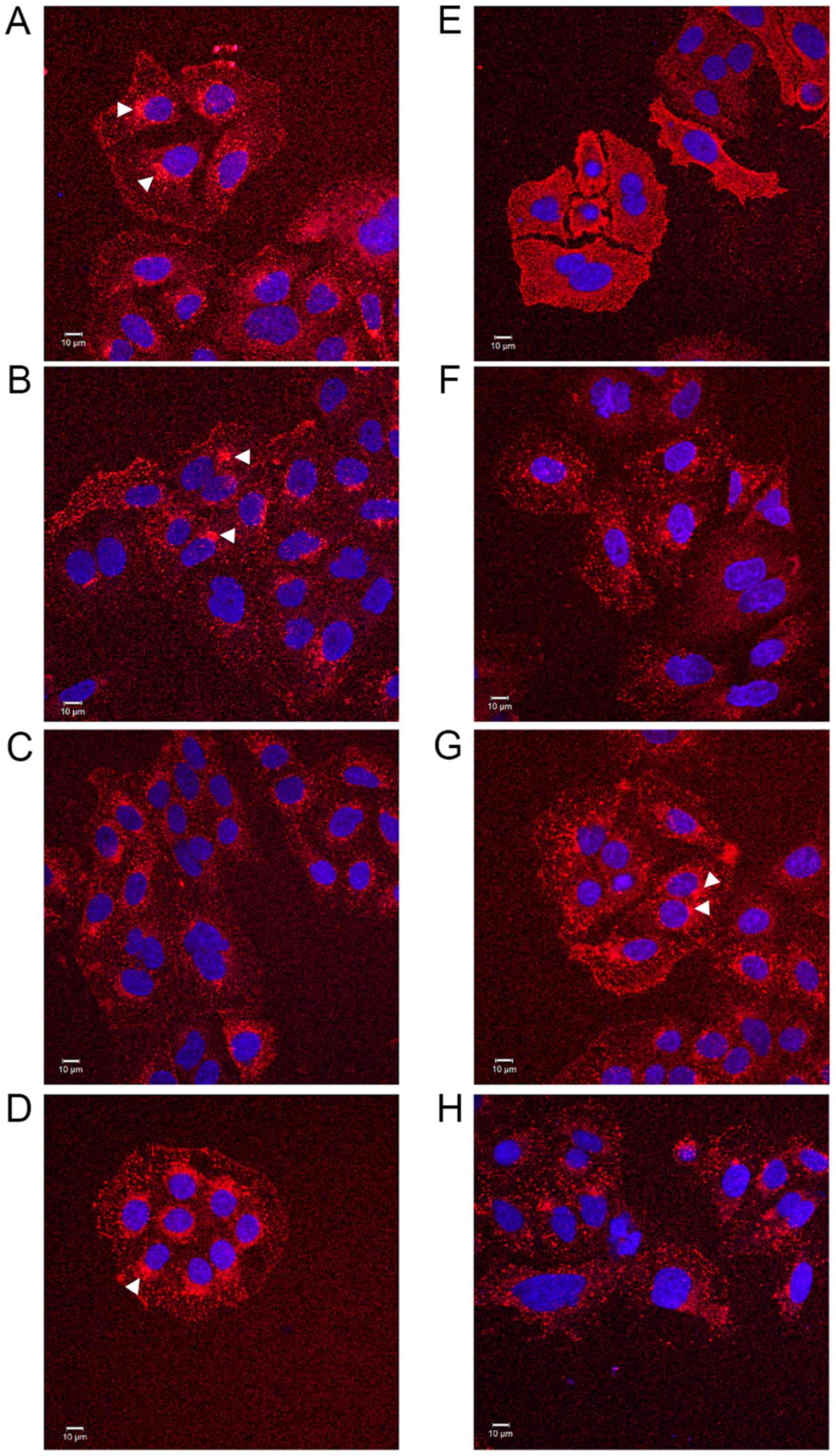 |
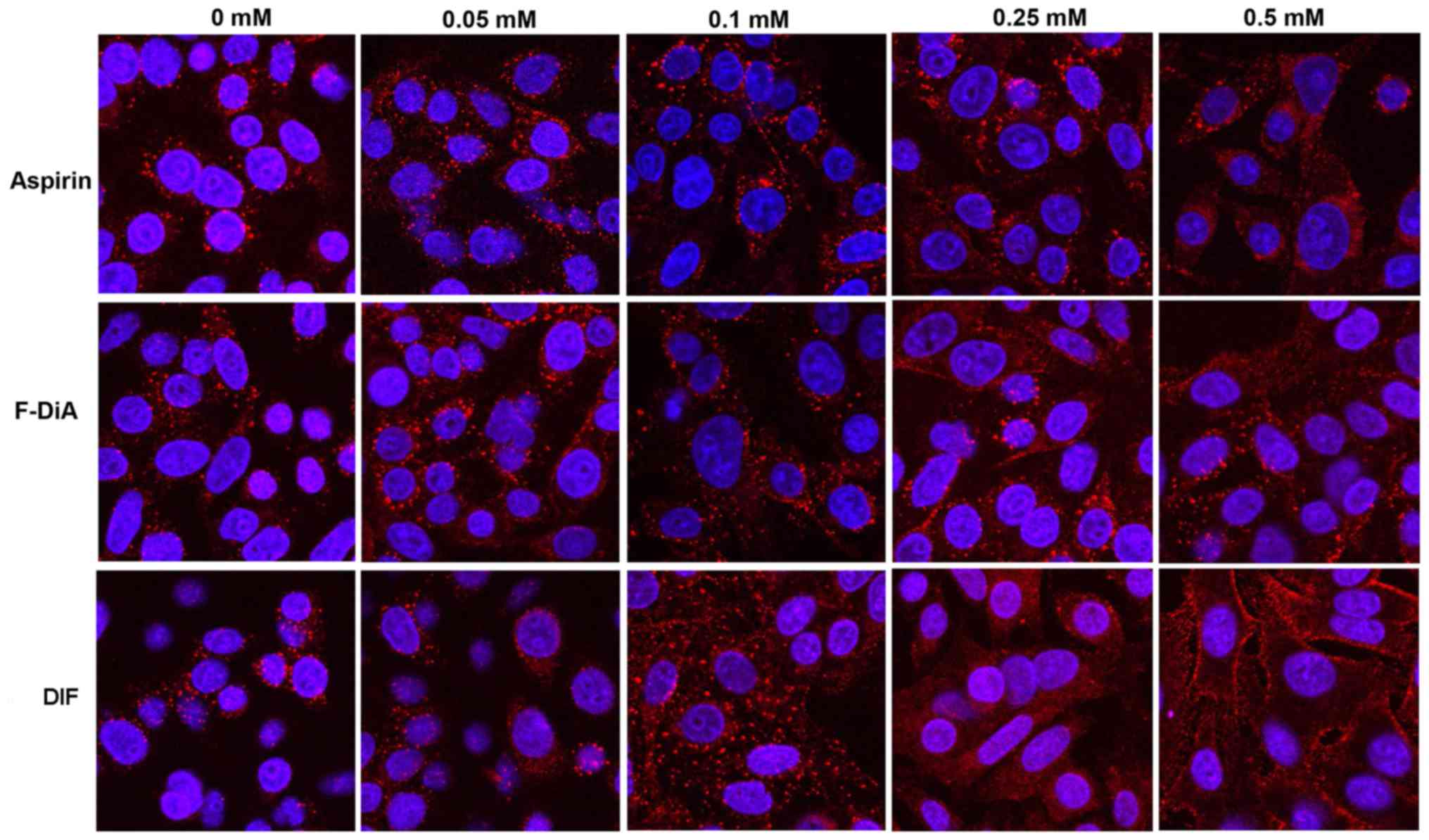 |
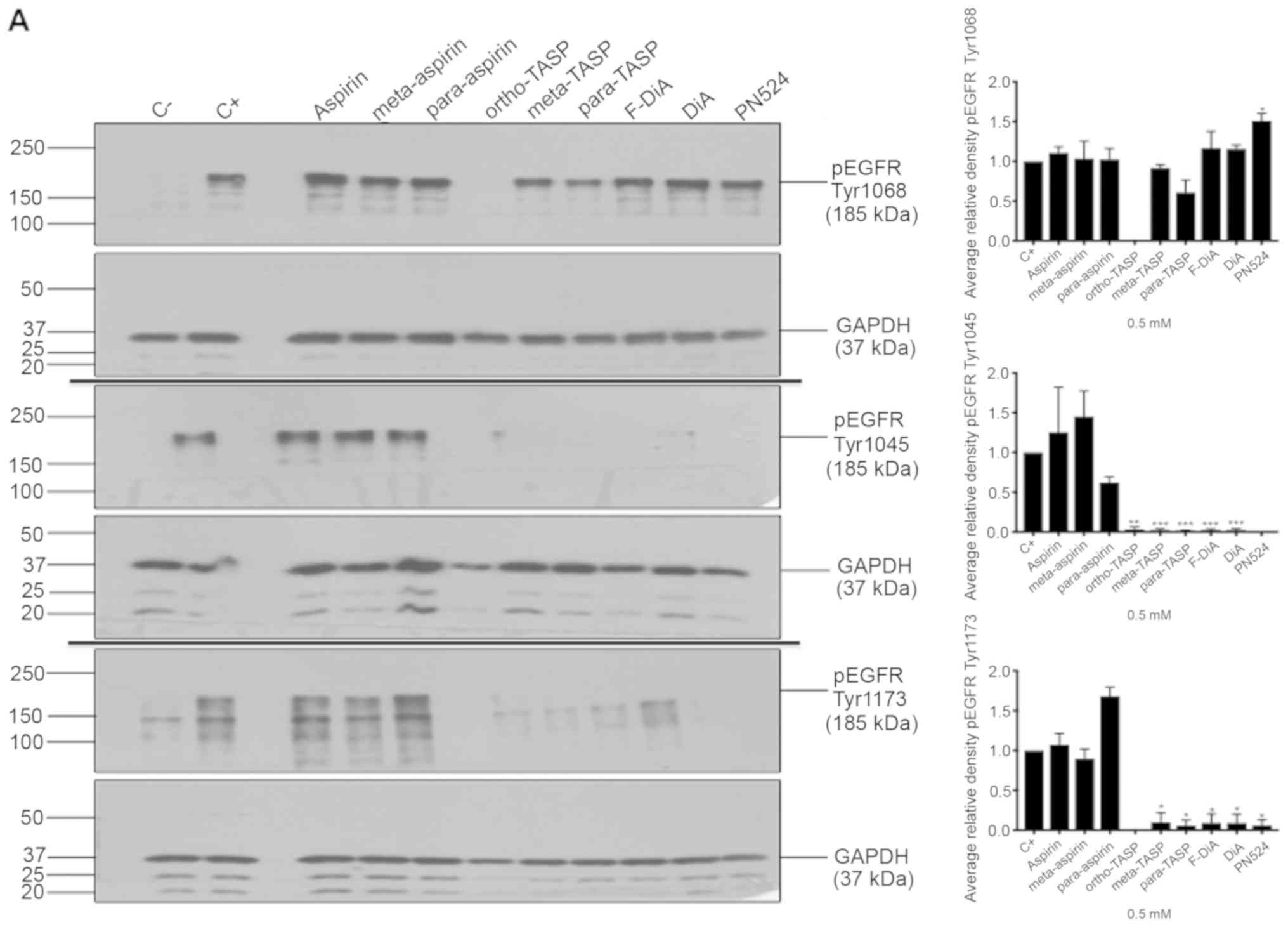 |
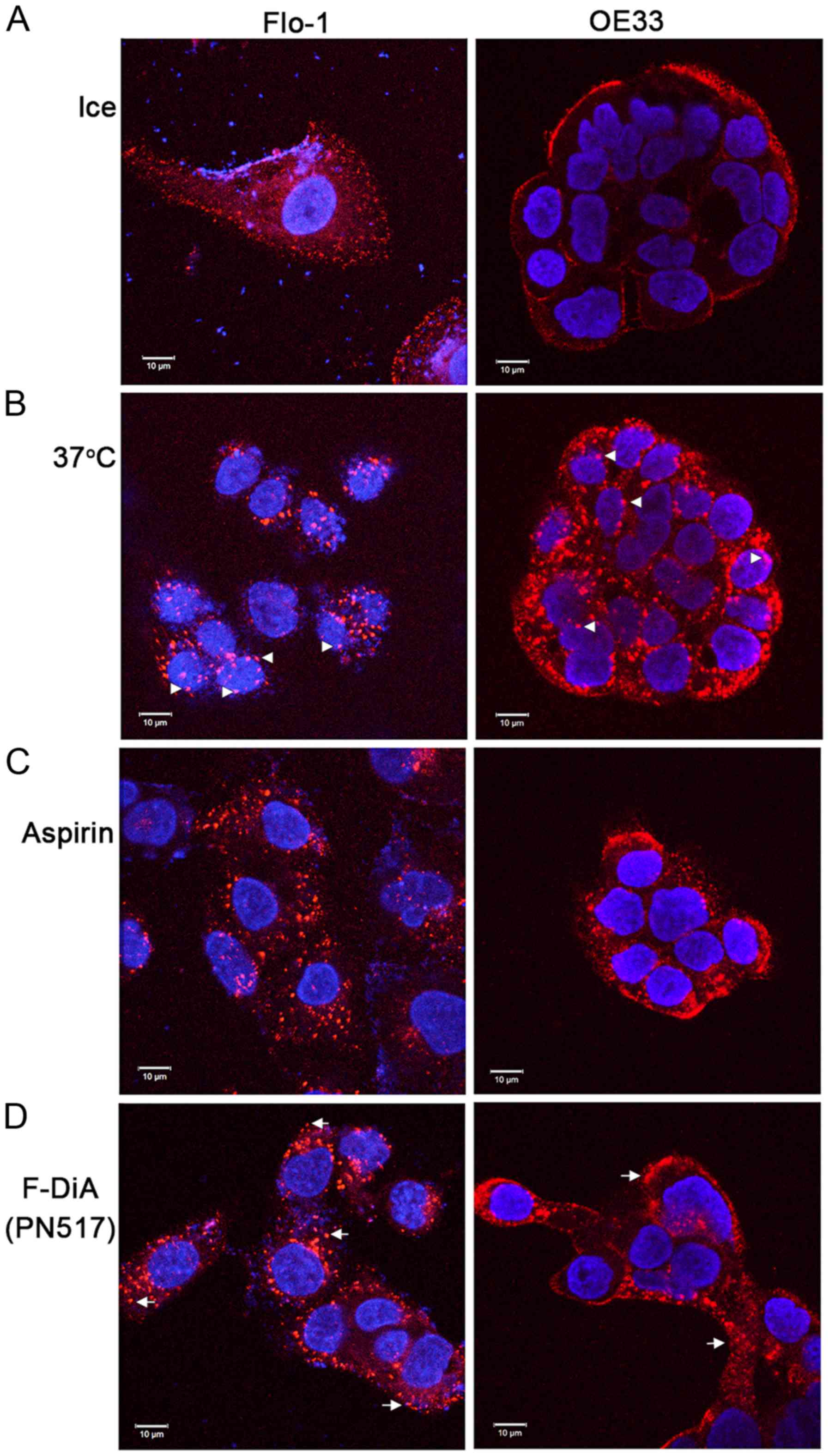 |
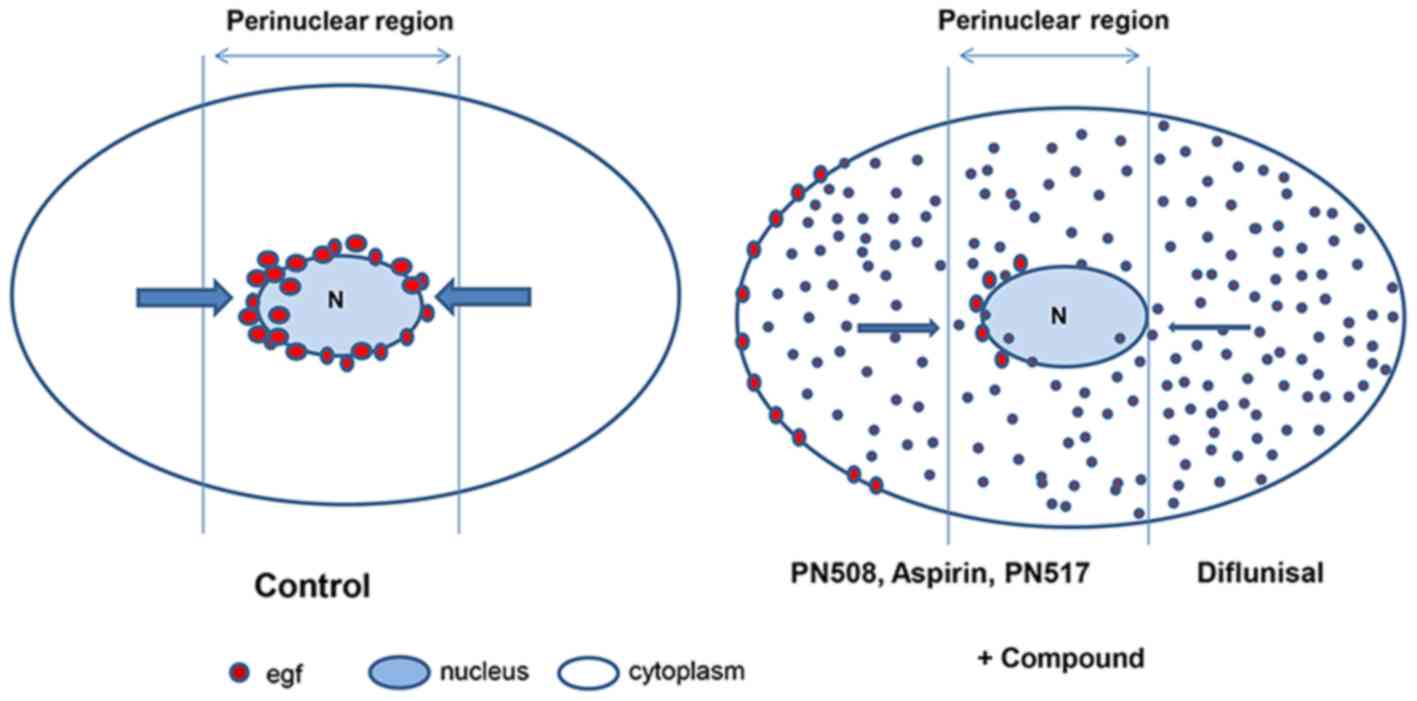 |
|
Garcia-Albeniz X and Chan AT: Aspirin for the prevention of colorectal cancer. Best Pract Res Clin Gastroenterol. 25:461–472. 2011. View Article : Google Scholar : PubMed/NCBI | |
|
Sung JJ, Lau JY, Goh KL and Leung WK; Asia Pacific Working Group on Colorectal Cancer: Increasing incidence of colorectal cancer in Asia: Implications for screening. Lancet Oncol. 6:871–876. 2005. View Article : Google Scholar : PubMed/NCBI | |
|
Kuriki K and Tajima K: The increasing incidence of colorectal cancer and the preventive strategy in Japan. Asian Pac J Cancer Prev. 7:495–501. 2006.PubMed/NCBI | |
|
Siegel RL, Fedewa SA, Anderson WF, Miller KD, Ma J, Rosenberg PS and Jemal A: Colorectal Cancer Incidence Patterns in the United States, 1974–2013 = J Natl Cancer Inst. 109:djw3222017. | |
|
Shaheen NJ, Straus WL and Sandler RS: Chemoprevention of gastrointestinal malignancies with nonsteroidal antiinflam-matory drugs. Cancer. 94:950–963. 2002. View Article : Google Scholar : PubMed/NCBI | |
|
Sandler RS, Halabi S, Baron JA, Budinger S, Paskett E, Keresztes R, Petrelli N, Pipas JM, Karp DD, Loprinzi CL, et al: A randomized trial of aspirin to prevent colorectal adenomas in patients with previous colorectal cancer. N Engl J Med. 348:883–890. 2003. View Article : Google Scholar : PubMed/NCBI | |
|
Chan AT, Arber N, Burn J, Chia WK, Elwood P, Hull MA, Logan RF, Rothwell PM, Schrör K and Baron JA: Aspirin in the chemoprevention of colorectal neoplasia: An overview. Cancer Prev Res (Phila). 5:164–178. 2012. View Article : Google Scholar | |
|
Bibbins-Domingo K: Aspirin Use for the Primary Prevention of Cardiovascular Disease and Colorectal Cancer: U.S. Preventive Services Task Force Recommendation Statement. Ann Intern Med. 164:836–845. 2016. View Article : Google Scholar : PubMed/NCBI | |
|
Liao X, Lochhead P, Nishihara R, Morikawa T, Kuchiba A, Yamauchi M, Imamura Y, Qian ZR, Baba Y, Shima K, et al: Aspirin use, tumor PIK3CA mutation, and colorectal-cancer survival. N Engl J Med. 367:1596–1606. 2012. View Article : Google Scholar : PubMed/NCBI | |
|
Liggett JL, Zhang X, Eling TE and Baek SJ: Anti-tumor activity of non-steroidal anti-inf lammatory drugs: Cyclooxygenase-independent targets. Cancer Lett. 346:217–224. 2014. View Article : Google Scholar : PubMed/NCBI | |
|
Thun MJ, Henley SJ and Patrono C: Nonsteroidal anti-inflammatory drugs as anticancer agents: Mechanistic, pharmacologic, and clinical issues. J Natl Cancer Inst. 94:252–266. 2002. View Article : Google Scholar : PubMed/NCBI | |
|
Brown JR and DuBois RN: COX-2: A molecular target for colorectal cancer prevention. J Clin Oncol. 23:2840–2855. 2005. View Article : Google Scholar : PubMed/NCBI | |
|
Chan AT, Ogino S and Fuchs CS: Aspirin and the risk of colorectal cancer in relation to the expression of COX-2. N Engl J Med. 356:2131–2142. 2007. View Article : Google Scholar : PubMed/NCBI | |
|
Bos CL, Kodach LL, van den Brink GR, Diks SH, van Santen MM, Richel DJ, Peppelenbosch MP and Hardwick JC: Effect of aspirin on the Wnt/beta-catenin pathway is mediated via protein phosphatase 2A. Oncogene. 25:6447–6456. 2006. View Article : Google Scholar : PubMed/NCBI | |
|
Kopp E and Ghosh S: Inhibition of NF-kappa B by sodium salicylate and aspirin. Science. 265:956–959. 1994. View Article : Google Scholar : PubMed/NCBI | |
|
Xu XM, Sansores-Garcia L, Chen XM, Matijevic-Aleksic N, Du M and Wu KK: Suppression of inducible cyclooxygenase 2 gene transcription by aspirin and sodium salicylate. Proc Natl Acad Sci USA. 96:5292–5297. 1999. View Article : Google Scholar : PubMed/NCBI | |
|
Yin MJ, Yamamoto Y and Gaynor RB: The anti-inflammatory agents aspirin and salicylate inhibit the activity of I(kappa)B kinase-beta. Nature. 396:77–80. 1998. View Article : Google Scholar : PubMed/NCBI | |
|
Goel A, Chang DK, Ricciardiello L, Gasche C and Boland CR: A novel mechanism for aspirin-mediated growth inhibition of human colon cancer cells. Clin Cancer Res. 9:383–390. 2003.PubMed/NCBI | |
|
Rüschoff J, Wallinger S, Dietmaier W, Bocker T, Brockhoff G, Hofstädter F and Fishel R: Aspirin suppresses the mutator phenotype associated with hereditary nonpolyposis colorectal cancer by genetic selection. Proc Natl Acad Sci USA. 95:11301–11306. 1998. View Article : Google Scholar : PubMed/NCBI | |
|
Din FV, Valanciute A, Houde VP, Zibrova D, Green KA, Sakamoto K, Alessi DR and Dunlop MG: Aspirin inhibits mTOR signaling, activates AMP-activated protein kinase, and induces autophagy in colorectal cancer cells. Gastroenterology. 142:1504–1515.e3. 2012. View Article : Google Scholar : PubMed/NCBI | |
|
Hawley SA, Fullerton MD, Ross FA, Schertzer JD, Chevtzoff C, Walker KJ, Peggie MW, Zibrova D, Green KA, Mustard KJ, et al: The ancient drug salicylate directly activates AMP-activated protein kinase. Science. 336:918–922. 2012. View Article : Google Scholar : PubMed/NCBI | |
|
Shirakawa K, Wang L, Man N, Maksimoska J, Sorum AW, Lim HW, Lee IS, Shimazu T, Newman JC, Schröder S, et al: Salicylate, diflunisal and their metabolites inhibit CBP/p300 and exhibit anticancer activity. Elife. 5:pii: e11156. 2016. View Article : Google Scholar : PubMed/NCBI | |
|
Pangburn HA, Kraus H, Ahnen DJ and Rice PL: Sulindac metabolites inhibit epidermal growth factor receptor activation and expression. J Carcinog. 4:162005. View Article : Google Scholar : PubMed/NCBI | |
|
Selvendiran K, Bratasz A, Tong L, Ignarro LJ and Kuppusamy P: NCX-4016, a nitro-derivative of aspirin, inhibits EGFR and STAT3 signaling and modulates Bcl-2 proteins in cisplatin-resistant human ovarian cancer cells and xenografts. Cell Cycle. 7:81–88. 2008. View Article : Google Scholar : PubMed/NCBI | |
|
Cho M, Kabir SM, Dong Y, Lee E, Rice VM, Khabele D and Son DS: Aspirin Blocks EGF-stimulated Cell Viability in a COX-1 Dependent Manner in Ovarian Cancer Cells. J Cancer. 4:671–678. 2013. View Article : Google Scholar : PubMed/NCBI | |
|
Deb J, Dibra H, Shan S, Rajan S, Manneh J, Kankipati CS, Perry CJ and Nicholl ID: Activity of aspirin analogues and vanillin in a human colorectal cancer cell line. Oncol Rep. 26:557–565. 2011.PubMed/NCBI | |
|
Claudius AK, Kankipati CS, Kilari RS, Hassan S, Guest K, Russell ST, Perry CJ, Stark LA and Nicholl ID: Identification of aspirin analogues that repress NF-κB signalling and demonstrate anti-proliferative activity towards colorectal cancer in vitro and in vivo. Oncol Rep. 32:1670–1680. 2014. View Article : Google Scholar : PubMed/NCBI | |
|
Ahmed D, Eide PW, Eilertsen IA, Danielsen SA, Eknæs M, Hektoen M, Lind GE and Lothe RA: Epigenetic and genetic features of 24 colon cancer cell lines. Oncogenesis. 2:e712013. View Article : Google Scholar : PubMed/NCBI | |
|
Shigeta K, Hayashida T, Hoshino Y, Okabayashi K, Endo T, Ishii Y, Hasegawa H and Kitagawa Y: Expression of epidermal growth factor receptor detected by cetuximab indicates its efficacy to inhibit in vitro and in vivo proliferation of colorectal cancer cells. PLoS One. 8:e663022013. View Article : Google Scholar : PubMed/NCBI | |
|
Richter M, Weiss M, Weinberger I, Fürstenberger G and Marian B: Growth inhibition and induction of apoptosis in colorectal tumor cells by cyclooxygenase inhibitors. Carcinogenesis. 22:17–25. 2001. View Article : Google Scholar : PubMed/NCBI | |
|
Lin PC, Lin YJ, Lee CT, Liu HS and Lee JC: Cyclooxygenase-2 expression in the tumor environment is associated with poor prognosis in colorectal cancer patients. Oncol Lett. 6:733–739. 2013. View Article : Google Scholar : PubMed/NCBI | |
|
Werner S and Grose R: Regulation of wound healing by growth factors and cytokines. Physiol Rev. 83:835–870. 2003. View Article : Google Scholar : PubMed/NCBI | |
|
Boonstra JJ, van Marion R, Beer DG, Lin L, Chaves P, Ribeiro C, Pereira AD, Roque L, Darnton SJ, Altorki NK, et al: Verification and unmasking of widely used human esophageal adenocar-cinoma cell lines. J Natl Cancer Inst. 102:271–274. 2010. View Article : Google Scholar : PubMed/NCBI | |
|
Cheong E, Ivory K, Doleman J, Parker ML, Rhodes M and Johnson IT: Synthetic and naturally occurring COX-2 inhibitors suppress proliferation in a human oesophageal adenocarcinoma cell line (OE33) by inducing apoptosis and cell cycle arrest. Carcinogenesis. 25:1945–1952. 2004. View Article : Google Scholar : PubMed/NCBI | |
|
Song S, Honjo S, Jin J, Chang SS, Scott AW, Chen Q, Kalhor N, Correa AM, Hofstetter WL, Albarracin CT, et al: The Hippo Coactivator YAP1 Mediates EGFR Overexpression and Confers Chemoresistance in Esophageal Cancer. Clin Cancer Res. 21:2580–2590. 2015. View Article : Google Scholar : PubMed/NCBI | |
|
Bosetti C, Talamini R, Franceschi S, Negri E, Garavello W and La Vecchia C: Aspirin use and cancers of the upper aerodigestive tract. Br J Cancer. 88:672–674. 2003. View Article : Google Scholar : PubMed/NCBI | |
|
Bosetti C, Gallus S and La Vecchia C: Aspirin and cancer risk: An updated quantitative review to 2005. Cancer Causes Control. 17:871–888. 2006. View Article : Google Scholar : PubMed/NCBI | |
|
Mosmann T: Rapid colorimetric assay for cellular growth and survival: Application to proliferation and cytotoxicity assays. J Immunol Methods. 65:55–63. 1983. View Article : Google Scholar : PubMed/NCBI | |
|
Carmichael J, DeGraff WG, Gazdar AF, Minna JD and Mitchell JB: Evaluation of a tetrazolium-based semiautomated colorimetric assay: Assessment of chemosensitivity testing. Cancer Res. 47:936–942. 1987.PubMed/NCBI | |
|
Laemmli UK: Cleavage of structural proteins during the assembly of the head of bacteriophage T4. Nature. 227:680–685. 1970. View Article : Google Scholar : PubMed/NCBI | |
|
Jiang X, Huang F, Marusyk A and Sorkin A: Grb2 regulates internalization of EGF receptors through clathrin-coated pits. Mol Biol Cell. 14:858–870. 2003. View Article : Google Scholar : PubMed/NCBI | |
|
Huang F, Khvorova A, Marshall W and Sorkin A: Analysis of clathrin-mediated endocytosis of epidermal growth factor receptor by RNA interference. J Biol Chem. 279:16657–16661. 2004. View Article : Google Scholar : PubMed/NCBI | |
|
Carpenter AE, Jones TR, Lamprecht MR, Clarke C, Kang IH, Friman O, Guertin DA, Chang JH, Lindquist RA, Moffat J, et al: CellProfiler: Image analysis software for identifying and quantifying cell phenotypes. Genome Biol. 7:R1002006. View Article : Google Scholar : PubMed/NCBI | |
|
Bordwell FG and Boutan PJ: Conjugative Effects in Divalent Sulfur Groupings1. J Am Chem Soc. 78:854–860. 1956. View Article : Google Scholar | |
|
Nelander L, Johansson G, Toplin I, Melera A and Nilsson L: The heats of hydrolysis of aspirin, thioaspirin, and their p-analogues. Acta Chem Scand. 18:973–984. 1964. View Article : Google Scholar | |
|
Schneider MR and Wolf E: The epidermal growth factor receptor ligands at a glance. J Cell Physiol. 218:460–466. 2009. View Article : Google Scholar | |
|
Yarden Y; The EGFR family and its ligands in human cancer: signalling mechanisms and therapeutic opportunities. Eur J Cancer. 37(Suppl 4): S3–S8. 2001. View Article : Google Scholar | |
|
Radinsky R, Risin S, Fan D, Dong Z, Bielenberg D, Bucana CD and Fidler IJ: Level and function of epidermal growth factor receptor predict the metastatic potential of human colon carcinoma cells. Clin Cancer Res. 1:19–31. 1995.PubMed/NCBI | |
|
Voldborg BR, Damstrup L, Spang-Thomsen M and Poulsen HS: Epidermal growth factor receptor (EGFR) and EGFR mutations, function and possible role in clinical trials. Ann Oncol. 8:1197–1206. 1997. View Article : Google Scholar | |
|
Citri A and Yarden Y: EGF-ERBB signalling: Towards the systems level. Nat Rev Mol Cell Biol. 7:505–516. 2006. View Article : Google Scholar : PubMed/NCBI | |
|
Spano JP, Lagorce C, Atlan D, Milano G, Domont J, Benamouzig R, Attar A, Benichou J, Martin A, Morere JF, et al: Impact of EGFR expression on colorectal cancer patient prognosis and survival. Ann Oncol. 16:102–108. 2005. View Article : Google Scholar | |
|
Normanno N, De Luca A, Bianco C, Strizzi L, Mancino M, Maiello MR, Carotenuto A, De Feo G, Caponigro F and Salomon DS: Epidermal growth factor receptor (EGFR) signaling in cancer. Gene. 366:2–16. 2006. View Article : Google Scholar | |
|
Shostak K and Chariot A: EGFR and NF-κB: Partners in cancer. Trends Mol Med. 21:385–393. 2015. View Article : Google Scholar : PubMed/NCBI | |
|
Habib AA, Chatterjee S, Park SK, Ratan RR, Lefebvre S and Vartanian T: The epidermal growth factor receptor engages receptor interacting protein and nuclear factor-kappa B (NF-kappa B)-inducing kinase to activate NF-kappa B. Identification of a novel receptor-tyrosine kinase signalosome. J Biol Chem. 276:8865–8874. 2001. View Article : Google Scholar | |
|
Taub N, Teis D, Ebner HL, Hess MW and Huber LA: Late endosomal traffic of the epidermal growth factor receptor ensures spatial and temporal fidelity of mitogen-activated protein kinase signaling. Mol Biol Cell. 18:4698–4710. 2007. View Article : Google Scholar : PubMed/NCBI | |
|
Murphy JE, Padilla BE, Hasdemir B, Cottrell GS and Bunnett NW: Endosomes: A legitimate platform for the signaling train. Proc Natl Acad Sci USA. 106:17615–17622. 2009. View Article : Google Scholar : PubMed/NCBI | |
|
Din FV, Dunlop MG and Stark LA: Evidence for colorectal cancer cell specificity of aspirin effects on NF kappa B signalling and apoptosis. Br J Cancer. 91:381–388. 2004. View Article : Google Scholar : PubMed/NCBI | |
|
Schwenger P, Bellosta P, Vietor I, Basilico C, Skolnik EY and Vilcek J: Sodium salicylate induces apoptosis via p38 mitogen-activated protein kinase but inhibits tumor necrosis factor-induced c-Jun N-terminal kinase/stress-activated protein kinase activation. Proc Natl Acad Sci USA. 94:2869–2873. 1997. View Article : Google Scholar : PubMed/NCBI | |
|
Frantz B, O’Neill EA, Ghosh S and Kopp E: The effect of sodium salicylate and aspirin on NF-kappa B. Science. 270:2017–2019. 1995. View Article : Google Scholar : PubMed/NCBI | |
|
Amann R and Peskar BA: Anti-inflammatory effects of aspirin and sodium salicylate. Eur J Pharmacol. 447:1–9. 2002. View Article : Google Scholar : PubMed/NCBI | |
|
Nordt SP, Clark RF, Castillo EM and Guss DA: Comparison of three aspirin formulations in human volunteers. West J Emerg Med. 12:381–385. 2011. View Article : Google Scholar | |
|
Borthwick GM, Johnson AS, Partington M, Burn J, Wilson R and Arthur HM: Therapeutic levels of aspirin and salicylate directly inhibit a model of angiogenesis through a Cox-independent mechanism. FASEB J. 20:2009–2016. 2006. View Article : Google Scholar : PubMed/NCBI | |
|
Dawson JP, Berger MB, Lin CC, Schlessinger J, Lemmon MA and Ferguson KM: Epidermal growth factor receptor dimerization and activation require ligand-induced conformational changes in the dimer interface. Mol Cell Biol. 25:7734–7742. 2005. View Article : Google Scholar : PubMed/NCBI | |
|
Hubbard SR and Miller WT: Receptor tyrosine kinases: Mechanisms of activation and signaling. Curr Opin Cell Biol. 19:117–123. 2007. View Article : Google Scholar : PubMed/NCBI | |
|
Arkhipov A, Shan Y, Das R, Endres NF, Eastwood MP, Wemmer DE, Kuriyan J and Shaw DE: Architecture and membrane interactions of the EGF receptor. Cell. 152:557–569. 2013. View Article : Google Scholar : PubMed/NCBI | |
|
Lemmon MA and Schlessinger J: Cell signaling by receptor tyrosine kinases. Cell. 141:1117–1134. 2010. View Article : Google Scholar : PubMed/NCBI | |
|
Huang L and Fu L: Mechanisms of resistance to EGFR tyrosine kinase inhibitors. Acta Pharm Sin B. 5:390–401. 2015. View Article : Google Scholar : PubMed/NCBI | |
|
Sigismund S, Woelk T, Puri C, Maspero E, Tacchetti C, Transidico P, Di Fiore PP and Polo S: Clathrin-independent endocytosis of ubiquitinated cargos. Proc Natl Acad Sci USA. 102:2760–2765. 2005. View Article : Google Scholar : PubMed/NCBI | |
|
Sigismund S, Argenzio E, Tosoni D, Cavallaro E, Polo S and Di Fiore PP: Clathrin-mediated internalization is essential for sustained EGFR signaling but dispensable for degradation. Dev Cell. 15:209–219. 2008. View Article : Google Scholar : PubMed/NCBI | |
|
Barbieri E, Di Fiore PP and Sigismund S: Endocytic control of signaling at the plasma membrane. Curr Opin Cell Biol. 39:21–27. 2016. View Article : Google Scholar : PubMed/NCBI | |
|
Burke P, Schooler K and Wiley HS: Regulation of epidermal growth factor receptor signaling by endocytosis and intracellular trafficking. Mol Biol Cell. 12:1897–1910. 2001. View Article : Google Scholar : PubMed/NCBI | |
|
Goh LK, Huang F, Kim W, Gygi S and Sorkin A: Multiple mechanisms collectively regulate clathrin-mediated endocytosis of the epidermal growth factor receptor. J Cell Biol. 189:871–883. 2010. View Article : Google Scholar : PubMed/NCBI | |
|
Mellman I and Yarden Y: Endocytosis and cancer. Cold Spring Harb Perspect Biol. 5:a0169492013. View Article : Google Scholar : PubMed/NCBI | |
|
Villaseñor R, Kalaidzidis Y and Zerial M: Signal processing by the endosomal system. Curr Opin Cell Biol. 39:53–60. 2016. View Article : Google Scholar : PubMed/NCBI | |
|
Wang YN, Yamaguchi H, Hsu JM and Hung MC: Nuclear trafficking of the epidermal growth factor receptor family membrane proteins. Oncogene. 29:3997–4006. 2010. View Article : Google Scholar : PubMed/NCBI | |
|
Wang YN and Hung MC: Nuclear functions and subcellular trafficking mechanisms of the epidermal growth factor receptor family. Cell Biosci. 2:132012. View Article : Google Scholar : PubMed/NCBI | |
|
Wang YN, Lee HH, Lee HJ, Du Y, Yamaguchi H and Hung MC: Membrane-bound trafficking regulates nuclear transport of integral epidermal growth factor receptor (EGFR) and ErbB-2. J Biol Chem. 287:16869–16879. 2012. View Article : Google Scholar : PubMed/NCBI | |
|
Brand TM, Iida M, Li C and Wheeler DL: The nuclear epidermal growth factor receptor signaling network and its role in cancer. Discov Med. 12:419–432. 2011.PubMed/NCBI | |
|
Jovic M, Sharma M, Rahajeng J and Caplan S: The early endosome: A busy sorting station for proteins at the crossroads. Histol Histopathol. 25:99–112. 2010. | |
|
Pálfy M, Reményi A and Korcsmáros T: Endosomal crosstalk: Meeting points for signaling pathways. Trends Cell Biol. 22:447–456. 2012. View Article : Google Scholar : PubMed/NCBI | |
|
Henriksen L, Grandal MV, Knudsen SL, van Deurs B and Grøvdal LM: Internalization mechanisms of the epidermal growth factor receptor after activation with different ligands. PLoS One. 8:e581482013. View Article : Google Scholar : PubMed/NCBI | |
|
Capuani F, Conte A, Argenzio E, Marchetti L, Priami C, Polo S, Di Fiore PP, Sigismund S and Ciliberto A: Quantitative analysis reveals how EGFR activation and downregulation are coupled in normal but not in cancer cells. Nat Commun. 6:79992015. View Article : Google Scholar : PubMed/NCBI | |
|
Pennock S and Wang Z: A tale of two Cbls: Interplay of c-Cbl and Cbl-b in epidermal growth factor receptor downregulation. Mol Cell Biol. 28:3020–3037. 2008. View Article : Google Scholar : PubMed/NCBI | |
|
Rojas M, Yao S and Lin YZ: Controlling epidermal growth factor (EGF)-stimulated Ras activation in intact cells by a cell-permeable peptide mimicking phosphorylated EGF receptor. J Biol Chem. 271:27456–27461. 1996. View Article : Google Scholar : PubMed/NCBI | |
|
Nyati MK, Morgan MA, Feng FY and Lawrence TS: Integration of EGFR inhibitors with radiochemotherapy. Nat Rev Cancer. 6:876–885. 2006. View Article : Google Scholar : PubMed/NCBI | |
|
Downward J, Waterfield MD and Parker PJ: Autophosphorylation and protein kinase C phosphorylation of the epidermal growth factor receptor. Effect on tyrosine kinase activity and ligand binding affinity. J Biol Chem. 260:14538–14546. 1985.PubMed/NCBI | |
|
Keilhack H, Tenev T, Nyakatura E, Godovac-Zimmermann J, Nielsen L, Seedorf K and Böhmer FD: Phosphotyrosine 1173 mediates binding of the protein-tyrosine phosphatase SHP-1 to the epidermal growth factor receptor and attenuation of receptor signaling. J Biol Chem. 273:24839–24846. 1998. View Article : Google Scholar : PubMed/NCBI | |
|
Hsu JM, Chen CT, Chou CK, Kuo HP, Li LY, Lin CY, Lee HJ, Wang YN, Liu M, Liao HW, et al: Crosstalk between Arg 1175 methylation and Tyr 1173 p hosphorylation negatively modulates EGFR-mediated ERK activation. Nat Cell Biol. 13:174–181. 2011. View Article : Google Scholar : PubMed/NCBI | |
|
Li H, Zhu F, Boardman LA, Wang L, Oi N, Liu K, Li X, Fu Y, Limburg PJ, Bode AM, et al: Aspirin Prevents Colorectal Cancer by Normalizing EGFR Expression. EBioMedicine. 2:447–455. 2015. View Article : Google Scholar : PubMed/NCBI | |
|
Murthy U, Basu M, Sen-Majumdar A and Das M: Perinuclear location and recycling of epidermal growth factor receptor kinase: Immunofluorescent visualization using antibodies directed to kinase and extracellular domains. J Cell Biol. 103:333–342. 1986. View Article : Google Scholar : PubMed/NCBI | |
|
Kesarwala AH, Samrakandi MM and Piwnica-Worms D: Proteasome inhibition blocks ligand-induced dynamic processing and internalization of epidermal growth factor receptor via altered receptor ubiquitination and phosphorylation. Cancer Res. 69:976–983. 2009. View Article : Google Scholar : PubMed/NCBI | |
|
Farrow DC, Vaughan TL, Hansten PD, Stanford JL, Risch HA, Gammon MD, Chow WH, Dubrow R, Ahsan H, Mayne ST, et al: Use of aspirin and other nonsteroidal anti-inflammatory drugs and risk of esophageal and gastric cancer. Cancer Epidemiol Biomarkers Prev. 7:97–102. 1998.PubMed/NCBI | |
|
Funkhouser EM and Sharp GB: Aspirin and reduced risk of esophageal carcinoma. Cancer. 76:1116–1119. 1995. View Article : Google Scholar : PubMed/NCBI | |
|
Kobayashi S, Shimamura T, Monti S, Steidl U, Hetherington CJ, Lowell AM, Golub T, Meyerson M, Tenen DG, Shapiro GI, et al: Transcriptional profiling identifies cyclin D1 as a critical downstream effector of mutant epidermal growth factor receptor signaling. Cancer Res. 66:11389–11398. 2006. View Article : Google Scholar : PubMed/NCBI | |
|
Thoms HC, Dunlop MG and Stark LA: p38-mediated inactivation of cyclin D1/cyclin-dependent kinase 4 stimulates nucleolar translocation of RelA and apoptosis in colorectal cancer cells. Cancer Res. 67:1660–1669. 2007. View Article : Google Scholar : PubMed/NCBI | |
|
Cavalli V, Vilbois F, Corti M, Marcote MJ, Tamura K, Karin M, Arkinstall S and Gruenberg J: The stress-induced MAP kinase p38 regulates endocytic trafficking via the GDI:Rab5 complex. Mol Cell. 7:421–432. 2001. View Article : Google Scholar : PubMed/NCBI | |
|
Fratti RA, Chua J and Deretic V: Induction of p38 mitogen-activated protein kinase reduces early endosome auto-antigen 1 (EEA1) recruitment to phagosomal membranes. J Biol Chem. 278:46961–46967. 2003. View Article : Google Scholar : PubMed/NCBI | |
|
Vergarajauregui S, San Miguel A and Puertollano R: Activation of p38 mitogen-activated protein kinase promotes epidermal growth factor receptor internalization. Traffic. 7:686–698. 2006. View Article : Google Scholar : PubMed/NCBI | |
|
Macé G, Miaczynska M, Zerial M and Nebreda AR: Phosphorylation of EEA1 by p38 MAP kinase regulates mu opioid receptor endocytosis. EMBO J. 24:3235–3246. 2005. View Article : Google Scholar : PubMed/NCBI | |
|
Higgs GA, Salmon JA, Henderson B and Vane JR: Pharmacokinetics of aspirin and salicylate in relation to inhibition of arachidonate cyclooxygenase and antiinflammatory activity. Proc Natl Acad Sci USA. 84:1417–1420. 1987. View Article : Google Scholar : PubMed/NCBI | |
|
Hatanpaa KJ, Burma S, Zhao D and Habib AA: Epidermal growth factor receptor in glioma: Signal transduction, neuropathology, imaging, and radioresistance. Neoplasia. 12:675–684. 2010. View Article : Google Scholar : PubMed/NCBI | |
|
Moris D, Kontos M, Spartalis E and Fentiman IS: The Role of NSAIDs in Breast Cancer Prevention and Relapse: Current Evidence and Future Perspectives. Breast Care (Basel). 11. pp. 339–344. 2016, View Article : Google Scholar | |
|
Taub M, Parker R, Mathivanan P, Ariff MA and Rudra T: Antagonism of the prostaglandin E2 EP1 receptor in MDCK cells increases growth through activation of Akt and the epidermal growth factor receptor. Am J Physiol Renal Physiol. 307:F539–F550. 2014. View Article : Google Scholar : PubMed/NCBI | |
|
Barrett MA, Zheng S, Roshankar G, Alsop RJ, Belanger RK, Huynh C, Kučerka N and Rheinstädter MC: Interaction of aspirin (acetylsalicylic acid) with lipid membranes. PLoS One. 7:e343572012. View Article : Google Scholar : PubMed/NCBI | |
|
Alsop RJ, Toppozini L, Marquardt D, Kučerka N, Harroun TA and Rheinstädter MC: Aspirin inhibits formation of cholesterol rafts in fluid lipid membranes. Biochim Biophys Acta. 1848.805–812. 2015. | |
|
Puri C, Tosoni D, Comai R, Rabellino A, Segat D, Caneva F, Luzzi P, Di Fiore PP and Tacchetti C: Relationships between EGFR signaling-competent and endocytosis-competent membrane microdomains. Mol Biol Cell. 16:2704–2718. 2005. View Article : Google Scholar : PubMed/NCBI |









